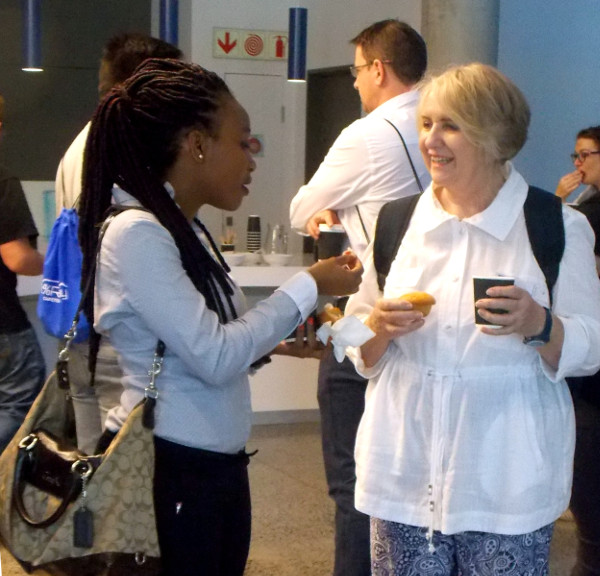SatRday taking centre stage at UCT
Researchers, data scientists, developers, novice coders and enthusiasts gathered at UCT in March for satRday: a series of workshops and conference sessions all about R, a statistical and graphical programming language and open-source software.

R enthusiasts connecting over a cuppa at satRday. Image courtesy of Kirsty Lee Garson.
Keynote speaker, Stephanie Kovalchik, research fellow at the Institute of Sport Exercise and Active Living at Victoria University and senior sports scientist at Tennis Australia explained the importance of the satRday meetup.
“A lot of the time R users spend with each other is online, which is great for preserving a year-round sense of cohesion, but you can’t replace person-to-person contact and these live conversations about what people are working on, what interesting packages they’ve found and what developments they would like to see.”
“You get to build relationships with people who are passionate about the same thing. You build contacts – potentially lifelong contacts – and friendships,” explains Vishalin Pillay, data analyst at Derivco. “And it’s a great forum for people who are new to R to learn from the experts.” Particularly in the hands-on workshops and between sessions networking in Hlanganani Junction, home to eResearch’s remarkable data visualisation wall, which successfully supports researcher engagement and facilitates data visualisation and analysis on campus.
The statistical capabilities of R, coupled with its active community of users, makes it a powerful means to effectively process and analyse big data. It is an open-source programming language built specifically for statistical analysis and enables users to create reproducible research which is fundamental to the project of Open Science.
Diversity through connection
SatRdays offer an arena in which local and international R users can connect and broaden their programming horizons. It also helps to break down barriers of affordability (as a low-cost event) and offers a space to invite new users to the community fostering inclusivity.
“One of our priorities has been to make the event as accessible as possible to the community,” Andrew Collier, one of the organisers, pointed out. “We have tried very hard to address the issues of gender imbalance that are common at these kinds of proceedings: we had three female keynote speakers last year and two female keynotes this year.”
Kovalchik is encouraged by the diversity both in the field – the different areas where people are applying R – and in the people – “more women, more minorities”. Although she notes that there is still a long way to go in terms of addressing issues of representation in the R community, Kovalchik simultaneously underscores the potential of satRdays to help.
“SatRday represents an opportunity to try to draw in more people from diverse backgrounds, by having speakers that represent them, to say, “Look: this can be done. I am doing this!” As well as by engaging new students who can potentially start to diversify the community more.
R-Ladies also fosters gender diversity in the R community. Its mission is to promote a balanced representation of minorities and support these R enthusiasts through a global network.
A tool for data science
R has been hailed as the lingua franca for data science – accessible to novices and academics, alike.
Sulona Nattan, an R enthusiast, mathematician and an attendee at the event, believes that the language is one of the most powerful tools for users to engage with data science and machine learning. Especially people that have more of a theoretical background and little practical programming knowledge, which is significant in this era of data-intensive research.
“As there’s more data in the world, there’s more opportunity to do research, become a data analyst, advance your career and learn,” says Nattan. “R is one of the best tools out there for novices.” It seems the R community is more than happy to welcome new users into its midst and offer support to those already passionate about R.
“One thing that should reassure new users coming to R is that there is a wealth of tools to make the work that you do much better and easier,” Kovalchik advocates. “All the people that have followed that path already, talk about it, and have put tutorials and information online to help you get started. The community loves welcoming new members who are in love with data science.”
Pillay’s advice is simple: “Go in there, get your hands dirty. You’ve got nothing to lose.
“There’s a reason that R is one of the fastest growing programming languages in the world and one of the most popular. So, if you have any interest in data science and analysis as well as machine learning – give it a try”.
